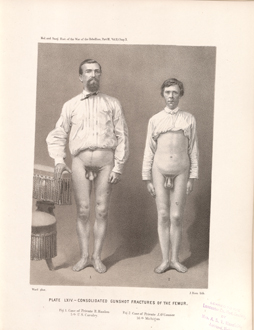Title: Hanlon, R.
Source text: The Medical and Surgical History of the War of the Rebellion. (1861-65.), Part 3, Volume 2 (Washington, DC: Government Printing Office, 1883), 196, 198.
Civil War Washington ID: med.d2e9516
TEI/XML: med.d2e9516.xml
CASE 402.—Private R. Hanlon, Co. C, 5th Cavalry, aged 21 years, was wounded at Beverly Ford, June 9, 1863. On the following day he was admitted to Lincoln Hospital, Washington, subsequently to Judiciary Square, and lastly to Carlisle Barracks, whence he was discharged May 16, 1864, and pensioned. Acting Assistant Surgeon G. K. Smith contributed the following history: "He was wounded by a minié ball, which entered the external aspect of the left thigh near its middle, comminuting the greater portion of the middle third of the femur, and splitting the lower third longitudinally nearly down to the knee joint. The missile lodged and could not be found. Ether was administered and the wound enlarged, and seventeen fragments of bone, comprising three inches of the continuity of the shaft, were removed. On June 23d, an abscess opened on the inner aspect of the thigh, near the perinæum, through which the ball was extracted. The limb was bandaged in its whole length, placed on a mattrass , and kept in position by a sand bag on either side. Owing to the loss of bone no extension was resorted to until October 1st, at which time the patient was able to roll his injured limb on the mattrass, the fragments having united, though the callus had not yet become firm and hard. I then applied a ten pound weight, suspended by a cord and pulley, and succeeded in reducing the shortening one-half inch. This amount of extension was continued until I left Lincoln Hospital, on November 8th, but was removed soon afterwards. On December 16th, while moving about on crutches, the patient fell and refractured the bone. The surgeon in charge then applied a long splint to the posterior aspect of the limb, retaining it in that position and preventing any motion of the knee joint until the fragments had reunited. The wound healed in the beginning of March, 1864, but broke open again in the middle of June, and continued to discharge slightly until March, 1865, during which time, however, the man was able to walk about and to serve as a watchman at the Government Repair Shops in Washington. On June 20th, 1865, the limb appeared perfectly sound, and at this period the man could walk all day without feeling tired, though there was fibrous anchylosis of the knee joint." Various pension examiners have certified at different dates to "anchylosis of the knee and about three inches shortening of the limb." The pensioner was paid June 4, 1879. PLATE LXIV, FIG. 1, opp. p. 198, represents his photograph, taken at the Army Medical Museum in June, 1865.—(Surg. Phot. Series, No. 55, A. M. M.)
